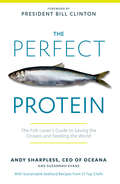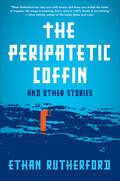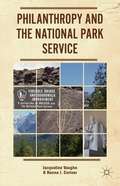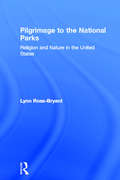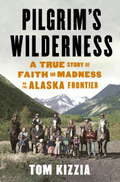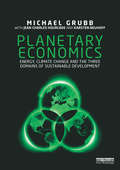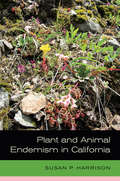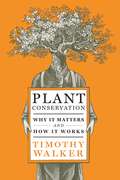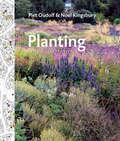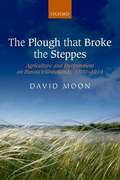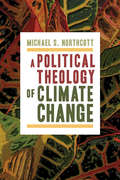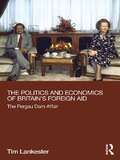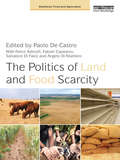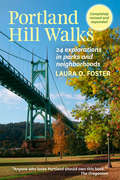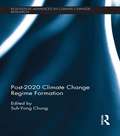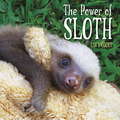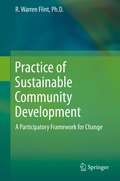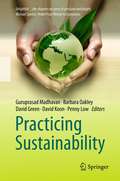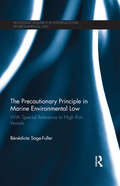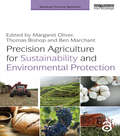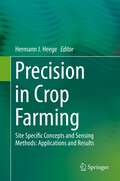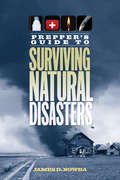- Table View
- List View
The Perfect Protein: The Fish Lover's Guide to Saving the Oceans and Feeding the World
by Andy Sharpless Suzannah EvansThe planet will be home to more than 9 billion people by 2050, and we're already seeing critical levels of famine around the world mirrored by growing obesity in developed nations. In The Perfect Protein, Andy Sharpless maintains that protecting wild seafood can help combat both issues, because seafood is the healthiest, cheapest, most environmentally friendly source of protein on earth. While the conservation community has taken a simplistic, save-the-whales approach when it comes to oceans, Sharpless contends that we must save the world's seafood not just to protect marine life and biodiversity but to stave off the coming humanitarian crisis. With high demand for predator species like tuna and salmon, wealthy nations like the U.S. convert "reduction" species such as anchovies, mackerel, and sardines into feed for salmon and other farmed animals—even though these overlooked fish are packed with health-boosting Omega-3 fatty acids and could feed millions. By establishing science-based quotas, protecting wild habitats, and reducing bycatch (and treating anchovies and their like as food, not feed), Sharpless believes that effective ocean stewardship can put healthy, sustainable seafood on the table forever. To that end, Oceana has tapped 20-plus chefs, including Mario Batali, Eric Ripert, and Jose Andres for recipes that give us all a role to play in this revolutionary mission: to save the fish so that we can eat more fish.
The Peripatetic Coffin and Other Stories
by Ethan RutherfordThe stories in The Peripatetic Coffin and Other Stories, a collection from Ethan Rutherford, map the surprising ways in which the world we think we know can unexpectedly reveal its darker contours.In stories that are alternately funny, persuasive, and compelling, unforgettable characters are confronted with, and battle against, the limitations of their lives.Rutherford’s work has been selected by Alice Sebold for inclusion in the volume of The Best American Short Stories that she edited, and also published in Ploughshares, One Story, and American Short Fiction.
Philanthropy And The National Park Service
by Jacqueline Vaughn Hanna J. CortnerAs the National Park Service prepares for its centennial in 2016, this book provides an in-depth analysis of the role of philanthropy in national parks, with a focus on non-profit organizations known as friends groups and cooperating associations. Providing a historical review of partnerships through the lifetime of the NPS, up to a contemporary analysis of the legal and organizational framework under which non-profit philanthropic partners operate, Jacqueline Vaughn and Hanna J. Cortner explore the challenges the National Park Service faces in dealing with non-profit partners. Based on personal interviews with more than 50 non-profit leaders and National Park Service staff, financial data, and comprehensive site visits, Vaughn and Cortner offer a unique and informative view of the landscape in which philanthropy groups succeed - and sometimes fail.
Pilgrimage to the National Parks: Religion and Nature in the United States (Routledge Studies in Pilgrimage, Religious Travel and Tourism)
by Lynn Ross-BryantNational Parks – ‘America’s Best Idea’ – were from the first seen as sacred sites embodying the God-given specialness of American people and American land, and from the first they were also marked as tourist attractions. The inherent tensions between these two realities ensured the parks would be stages where the country’s conflicting values would be performed and contested. As pilgrimage sites embody the values and beliefs of those who are drawn to them, so Americans could travel to these sacred places to honor, experience, and be restored by the powers that had created the American land and the American enterprise. This book explores the importance of the discourse of nature in American culture, arguing that the attributes and symbolic power that had first been associated with the ‘new world’ and then the ‘frontier’ were embodied in the National Parks. Author Ross-Bryant focuses on National Parks as pilgrimage sites around which a discourse of nature developed and argues the centrality of religion in understanding the dynamics of both the language and the ritual manifestations related to National Parks. Beyond the specific contribution to a richer analysis of the National Parks and their role in understanding nature and religion in the U.S., this volume contributes to the emerging field of ‘religion and the environment,’ larger issues in the study of religion (e.g. cultural events and the spatial element in meaning-making), and the study of non-institutional religion.
Pilgrim's Wilderness: A True Story of Faith and Madness on the Alaska Frontier
by Tom KizziaInto the Wild meets Helter Skelter in this riveting true story of a modern-day homesteading family in the deepest reaches of the Alaskan wilderness--and of the chilling secrets of its maniacal, spellbinding patriarch. When Papa Pilgrim, his wife, and their fifteen children appeared in the Alaska frontier outpost of McCarthy, their new neighbors saw them as a shining example of the homespun Christian ideal. But behind the family's proud piety and beautiful old-timey music lay Pilgrim's dark past: his strange connection to the Kennedy assassination and a trail of chaos and anguish that followed him from Dallas and New Mexico. Pilgrim soon sparked a tense confrontation with the National Park Service fiercely dividing the community over where a citizen's rights end and the government's power begins. As the battle grew more intense, the turmoil in his brood made it increasingly difficult to tell whether his children were messianic followers or hostages in desperate need of rescue. In this powerful piece of Americana, written with uncommon grace and high drama, veteran Alaska journalist, Tom Kizzia uses his unparalleled access to capture an era-defining clash between environmentalists and pioneers ignited by a mesmerizing sociopath who held a town and a family captive.
Planet Ocean
by Jan Dutkiewicz Paul WatsonVeteran environmental activist and Whale Wars host Paul Watson offers in this interview a provocative and revolutionary view of the state of an environment in crisis. The planet may survive our environmental destruction, he argues, but humans may not. Focused on protecting oceans, preventing the loss of biodiversity, and promoting individual action, Watson's singular call to arms challenges the typical talking points of the modern environmental movement.
Planetary Economics: Energy, climate change and the three domains of sustainable development
by Michael GrubbHow well do our assumptions about the global challenges of energy, environment and economic development fit the facts? Energy prices have varied hugely between countries and over time, yet the share of national income spent on energy has remained surprisingly constant. The foundational theories of economic growth account for only about half the growth observed in practice. Despite escalating warnings for more than two decades about the planetary risks of rising greenhouse gas emissions, most governments have seemed powerless to change course. Planetary Economics shows the surprising links between these seemingly unconnected facts. It argues that tackling the energy and environmental problems of the 21st Century requires three different domains of decision-making to be recognised and connected. Each domain involves different theoretical foundations, draws on different areas of evidence, and implies different policies. The book shows that the transformation of energy systems involves all three domains - and each is equally important. From them flow three pillars of policy – three quite distinct kinds of actions that need to be taken, which rest on fundamentally different principles. Any pillar on its own will fail. Only by understanding all three, and fitting them together, do we have any hope of changing course. And if we do, the oft-assumed conflict between economy and the environment dissolves – with potential for benefits to both. Planetary Economics charts how.
Plant and Animal Endemism in California
by Susan P. HarrisonCalifornia is globally renowned for its biological diversity, including its wealth of unique, or endemic, species. Many reasons have been cited to explain this abundance: the complex geology and topography of its landscape, the special powers of its Mediterranean-type climate, and the historic and modern barriers to the wider dispersal of its flora and fauna. Plant and Animal Endemism in California compiles and synthesizes a wealth of data on this singular subject, providing new and updated lists of native species, comparing patterns and causes of both plant and animal endemism, and interrogating the classic explanations proposed for the state's special significance in light of new molecular evidence. Susan Harrison also offers a summary of the innovative tools that have been developed and used in California to conserve and protect this stunning and imperiled diversity.
Plant Conservation: Why It Matters and How It Works
by Timothy WalkerPlants’ ability to turn sunlight into energy makes them the basis for all life; without them there is no life. And they are more than just a food source—they provide us with fuel, fibers, and pharmaceuticals. Global warming and the destruction of natural habitats are a serious threat to many plants, and there are worldwide efforts to mitigate the disaster. Plant Conservation tackles this essential topic head on. Timothy Walker, as the director of the Oxford Botanical Garden, a leader in the field of plant conservation, plays a key role in this effort. He highlights what is happening now, from cataloging the world’s flora to conservation efforts like protecting plants from overcollecting. He also shows home gardeners how they can become involved, whether by growing their own food to decrease reliance on large agriculture or by making smart plant choices by growing natives and avoiding invasives. Plant Conservation treats a critical topic in an accessible and optimistic way. It is required reading for students, professionals, and anyone with a keen interest in the importance of plants.
Planting: A New Perspective
by Noel Kingsbury Piet OudolfPlanting: A New Perspective is an essential resource for designers and gardeners looking to create plant-rich, beautiful gardens that support biodiversity and nourish the human spirit. An intimate knowledge of plants is essential to the success of modern landscape design, and Planting makes Oudolf’s considerable understanding of plant ecology and performance accessible, explaining how plants behave in different situations, what goes on underground, and which species make good neighbors. Extensive plant charts and planting plans will help you choose plants for their structure, color, and texture as well as the way they perform in the landscape. A detailed directory with details like each plant’s life expectancy, the persistence of its seedheads, its tendency to spread, and propensity to self-seed, this book is a beautiful and invaluable resource.
Plants that Trick and Trap (Fountas & Pinnell LLI Red #Level L)
by Julie WinterbottomHow do greenthings avoid mean things? Plants have remarkable ways of defending themselves. From dazzling disguises to powerful poisons, they could earn a black belt in self-defense!
The Plough that Broke the Steppes: Agriculture and Environment on Russia's Grasslands, 1700-1914
by David MoonThis is the first environmental history of Russia's steppes. From the early-eighteenth century, settlers moved to the semi-arid but fertile grasslands from wetter, forested regions in central and northern Russia and Ukraine, and from central Europe. By the late-nineteenth century, they had turned the steppes into the bread basket of the Russian Empire and parts of Europe. But there was another side to this story. The steppe region was hit by recurring droughts, winds from the east whipped up dust storms, the fertile black earth suffered severe erosion, crops failed, and in the worst years there was famine. David Moon analyses how naturalists and scientists came to understand the steppe environment, including the origins of the fertile black earth. He also analyses how scientists tried to understand environmental change, including climate change. Farmers, and the scientists who advised them, tried different ways to deal with the recurring droughts: planting trees, irrigation, and cultivating the soil. More sustainable, however, were techniques of cultivation to retain scarce moisture in the soil. Among the pioneers were Mennonite settlers. Such approaches aimed to work with the environment, rather than trying to change it by planting trees or supplying more water artificially. The story is similar to the Dust Bowl on the Great Plains of the USA, which share a similar environment and environmental history. David Moon places the story of the steppes in the wider context of the environmental history of European colonialism around the globe.
The Pocket Guide to Wild Mushrooms: Helpful Tips for Mushrooming in the Field
by Pelle Holmberg Hans MarklundWhen you're in the wild and you spot a nice-looking mushroom, how do you know if it is safe to eat? Question no more with the The Pocket Guide to Wild Mushrooms. This tiny companion is the perfect book to bring along when foraging for delectable fungi. Inside its neatly arranged pages are fifty-two edible mushrooms as well as the mushrooms with which they are often confused, whether edible or toxic.Beautiful photographs adorn the pages with mushrooms in the wild as well as picked, showing them from a multitude of angles. Study these photographs and you will become adept at recognizing edible and safe mushrooms. Even those who are unfamiliar with the mushroom forest can make a start at foraging with this instructional work, and, with the help of The Pocket Guide to Wild Mushrooms, can become experts in no time.Using practical symbol systems, distribution maps, and tips on picking, cleaning, cooking, and canning, the reader will also become familiar with a wide variety of wild mushrooms, including morels, black trumpets, chanterelles, sheep polypore, porcini, a variety of boletes, and many more. Grabbing this guide on the way out to go hunt for mushrooms will ensure a successful foraging experience.
A Political Theology of Climate Change
by Michael S. NorthcottMuch current commentary on climate change, both secular and theological, focuses on the duties of individual citizens to reduce their consumption of fossil fuels. In A Political Theology of Climate Change, however, Michael Northcott discusses nations as key agents in the climate crisis.Against the anti-national trend of contemporary political theology, Northcott renarrates the origins of the nations in the divine ordering of history. In dialogue with Giambattista Vico, Carl Schmitt, Alasdair MacIntyre, and other writers, he argues that nations have legal and moral responsibilities to rule over limited terrains and to guard a just and fair distribution of the fruits of the earth within the ecological limits of those terrains.As part of his study, Northcott brilliantly reveals how the prevalent nature-culture divide in Western culture, including its notion of nature as "private property," has contributed to the global ecological crisis. While addressing real difficulties and global controversies surrounding climate change, Northcott presents substantial and persuasive fare in his Political Theology of Climate Change.
The Politics and Economics of Britain's Foreign Aid: The Pergau Dam Affair (Routledge Explorations in Development Studies)
by Tim LankesterThe Pergau dam in Malaysia was the most controversial project in the history of British aid. Because of its high cost, it was a poor candidate for aid funding. It was provided in part to honour a highly irregular promise of civil aid in connection with a major arms deal. After two parliamentary inquiries and intense media coverage, in a landmark judgement the aid for Pergau was declared unlawful. Tim Lankester offers a detailed case study of this major aid project and of government decision-making in Britain and Malaysia. Exposing the roles played by key politicians and other stakeholders on both sides, he analyses the background to the aid/arms linkage, and the reasons why the British and Malaysian governments were so committed to the project, before exploring the response of Britain’s Parliament, and its media and NGOs, and the resultant legal case. The main causes of the Pergau debacle are carefully drawn out, from conflicting policy agendas within the British government to the power of the business lobby and the inability of Parliament to provide any serious challenge. Finally, Lankester asks whether, given what was known at the time and what we know now, he and his colleagues in Britain’s aid ministry were correct in their objections to the project. Pergau is still talked about as a prime example of how not to do aid. Tim Lankester, a key figure in the affair, is perfectly placed to provide the definitive account. At a time when aid budgets are under particular scrutiny, it provides a cautionary tale.
The Politics of Land and Food Scarcity (Earthscan Food and Agriculture)
by Paolo De CastroIn recent years the issue of food security has become centre stage in the global agenda. Since the 2007/8 food price crisis, a number of works have been published on the topic, addressed from various perspectives: economic, social and cultural, environmental, agronomic and climate change. Very rarely is there a comprehensive approach, which also includes the crucial issue of politics. Through a multidisciplinary approach, this book provides an overview of the new global challenges connected with land, food supply and agriculture. It also contributes to engagement in a new global food policy, through a political analysis of land and food scarcity, including 'land grabs' by affluent countries in poorer nations. It does not simply raise the debate; rather it aspires to move forward the debate that has started with the G20 meetings. It discusses how national governments, local agricultural policies and supranational entities are facing the new scenario of feeding a growing population when land resources are limited and subject to competing claims.
Portland Hill Walks: 24 Explorations in Parks and Neighborhoods, Completely Revised and Expanded
by Laura O. FosterPortland Hill Walks features twenty-four miniature adventures stocked with stunning views, hidden stairways, leafy byways, urban forests, and places to sit, eat, and soak in the local scene. The revised and updated edition offers five new walks in addition to the well-loved classics, with new contemporary and historical photos and easier-to-follow directions.Whether you feel like meandering through old streetcar neighborhoods or climbing a lava dome, there is a hill walk for every mood. New walks take you up to Willamette Stone State Park, across the St. Johns Bridge, down to the South Waterfront (with a ride on the aerial tram), along a stream in Gresham, and up Mounts Talbert and Scott.Portland is a walking city, and Portland Hill Walks will inspire you to enjoy it to its fullest!
Post-2020 Climate Change Regime Formation (Routledge Advances in Climate Change Research)
by Suh-Yong ChungThe fate of the climate change regime hangs in the balance as the UN-led negotiations try to forge a new international strategy for the post-2020 period. Since 1992, the UNFCCC and its Kyoto Protocol has been the primary legal instrument to respond to the climate challenge. However, the intergovernmental process has been riddled with problems that have rendered it ineffective. The changing economic landscape has further made this country grouping problematic as some developing countries now emit more than some of their advanced counterparts. Such problems have crippled the existing regime in adequately addressing climate change. Building upon the expertise of the contributors of this volume, this ground-breaking collection aims to show the way forward for the intergovernmental process. It is the first of its kind to explore the key features of the regime, featuring meticulously researched pieces from leading experts in the field. Each chapter responds to the questions surrounding the political and structural limitations of the current top-down approach taken in climate negotiations and proposes various alternatives countries can take to overcome such limitations in the process of building the post-2020 climate change regime. In particular, this collection underscores the concept of low-carbon development and green growth to make the climate change regime more effective.
The Power of Sloth
by Lucy CookeThe Power of Sloth is Lucy Cooke's celebration of the sloth: the cutest, cuddliest, slowest creature on this planet. In the book she brings together some truly adorable pictures of baby sloths, literally by the bucketful. These delightful, funny pictures are accompanied by a simple text which tells you all about sloths and why we should protect them. We also discover all about the work of the Avarios sloth sanctuary, which, along with the ZSL EDGE programme to protect the pygmy sloth, receives some of the proceeds from this book. This book has been a huge success in the USA, where is was published under the title of The Little Book of Sloth, selling over 50,000 copies and making the New York Times best-seller list.
Practice of Sustainable Community Development
by R. Warren FlintOrdinary people, community leaders, and even organizations and corporations still do not fully comprehend the interconnected, "big picture" dynamics of sustainability theory and action. In exploring means to become more sustainable, individuals and groups need a reference in which to frame discussions so they will be relevant, educational, and successful when implemented. This book puts ideas on sustainable communities into a conceptual framework that will promote striking, transformational effects on decision-making. In this book practitioners and community leaders will find effective, comprehensive tools and resources at their finger-tips to facilitate sustainable community development (SCD). The book content examines a diverse range of SCD methods; assessing community needs and resources; creating community visions; promoting stakeholder interest and participation; analyzing community problems; designing and facilitating strategic planning; carrying out interventions to improve
Practicing Sustainability
by David Green Barbara Oakley Penny Low Guru Madhavan David KoonSustainability applies to everybody. But everybody applies it differently, by defining and shaping it differently--much as water is edged and shaped by its container. It is conceived in absolute terms but underpinned by a great diversity of relatively "green"--and sometimes contradictory--practices that can each make society only more or less sustainable. In Practicing Sustainability, chefs, poets, music directors, evangelical pastors, skyscraper architects, artists, filmmakers, as well as scientific leaders, entrepreneurs, educators, business executives, policy makers, and the contrarians, shed light on our understanding of sustainability and the role that each of us can play. Each contributor addresses what sustainability means, what is most appealing about the concept, and what they would like to change to improve the perception and practice of sustainability. What emerges from their essays is a wide spectrum of views that confirm an important insight: Sustainability is pursued in different ways not only due to different interpretations, but also because of varying incentives, trade-offs, and altruistic motives. Practicing and achieving sustainability starts with a willingness to look critically at the concept. It also means enabling rich and vigorous discussion based on pragmatism and common sense to determine a framework for best ideas and practices. With time and the much needed critical thinking, sustainable development will become a more integral part of our culture. By sharing experiences and crisp insights from today's savants, Practicing Sustainability serves as a stepping stone to the future.
The Precautionary Principle in Marine Environmental Law: With Special Reference to High Risk Vessels (Routledge Research in International Environmental Law)
by Bénédicte Sage-FullerThe book examines whether the jurisdiction of coastal States under international law can be extended to include powers of intervention towards vessels posing a significant risk to their coastal and marine environment, but which have not yet been involved in any incident or accident. The books sets out how it is that coastal State jurisdiction can indeed be seen as including powers of intervention towards High Risks Vessels before an incident or accident happens, on the basis of the precautionary principle. The precautionary principle requires taking action when a risk of damage to the environment is suspected, but cannot be confirmed scientifically.The book thus considers the potential opportunities for the coastal state under international law to regulate international shipping where they consider vessels to an unacceptable risk to the environment, in order to prevent or minimise the risk of occurrence of the accident or incident leading to damage. The book acknowledges that this puts into question some very old and established principles of the law of the sea, most importantly the principle of freedom of navigation. But Bénédicte Sage-Fuller contends that this change would itself be a consequence of the evolution, since the end of WWII, of on the one hand international law of the sea itself, and of international environmental law on the other hand.
Precision Agriculture for Sustainability and Environmental Protection (Earthscan Food and Agriculture)
by Margaret A. Oliver Thomas F. A. Bishop Ben P. MarchantPrecision agriculture (PA) involves the application of technologies and agronomic principles to manage spatial and temporal variation associated with all aspects of agricultural production in order to improve crop performance and environmental quality. The focus of this book is to introduce a non-specialist audience to the the role of PA in food security, environmental protection, and sustainable use of natural resources, as well as its economic benefits. The technologies covered include yield monitors and remote sensing, and the key agronomic principles addressed are the optimal delivery of fertilizers, water and pesticides to crops only when and where these are required. As a result, it is shown that both food production and resource efficiency can be maximized, without waste or damage to the environment, such as can occur from excessive fertilizer or pesticide applications. The authors of necessity describe some technicalities about PA, but the overall aim is to introduce readers who are unfamiliar with PA to this very broad subject and to demonstrate the potential impact of PA on the environment and economy. Chapter 3 of this book is freely available as a downloadable Open Access PDF under a Creative Commons Attribution-Non Commercial-No Derivatives 3.0 license. https://s3-us-west-2.amazonaws.com/tandfbis/rt-files/docs/Open+Access+Chapters/9780415504409_oaChapter_3.pdf
Precision in Crop Farming: Applications and Results
by Hermann HeegeHigh yields and environmental control in crop farming call for precise adaptations to local growing conditions. Treating large fields in a uniform way by high capacity machinery cannot be regarded as a sustainable method for many situations. Because differences existing within single fields must be considered. The transition from former field work carried out manually or by small implements to present-day high-capacity machinery caused that the farmers lost the immediate and close contact with soils and crops. However, modern sensing and controlling technology can make up for this deficit. High tech methods that include proximal sensing and signals from satellites can provide for controls that allow adjusting farming operations to small fractions of one ha and sometimes even down to some m2, hence in a site-specific mode. This applies to operations for soil cultivation, sowing, fertilizing and plant protection. This book deals with site-specific concepts, applications and results.
Prepper's Guide to Surviving Natural Disasters: How to Prepare for Real-World Emergencies
by James D. NowkaReal disasters - floods, fires, tornadoes, hurricanes, chemical spills - occur every year. Prepper's Guide to Natural Disasters skips the hype and hysteria of less likely, apocalyptic scenarios and helps you understand, prepare for, and survive real threats to your family and home - events that affect hundreds of thousands of people every year. The Prepper's Guide to Natural Disasters helps you assess the real threats in your part of the country, then provides clear, detailed solutions to help you prepare for and survive these events.
